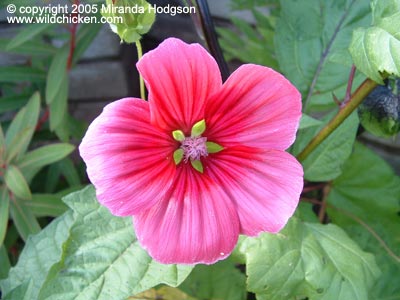

Malope trifida (also called annual malope, mallow wort and mallowwort)
Malope
trifida
Herbaceous annual grown for large, pink, Lavatera-like flowers. Easy and quite fast growing, this bushy plant makes an excellent filler for summer borders. The flowers are not so densely borne that they look garish, but still bring plenty of bright colour to the garden.
Flowers in summer. Seed heads are attractive in autumn.
Habit - roughly upright, branched, may need some support if this is not given by nearby plants. H&S: up to 1m.
Stems - smooth, very occasionally with short hairs, mid to bright green with tinges of red.
Leaves - lower leaves are rounded, slightly lobed and serrated. Upper leaves are more deeply and palmately lobed.
Flowers - 5 petals, rich crimson with some darker stripes, trumpet-shaped with pink-purple stamens. Borne on slender stems and held roughly upright.
Seeds - the calyx persists, twisting and enclosing the seeds, which are more or less spherical and brown.
Sun to partial shade, though does better in full sun.
In my experience, any fertile well drained soil will do.
Not hardy.
Dead head to prolong flowering. Collect seed in autumn for next year.
My plants were attacked by slugs this year (2005 was Year of the Slug in this garden), though this has never happened before.
Said to be susceptible to Hollyhock rust, but this hasn't happened to my plants, although the hollyhocks do get rust.
Sow seed in spring at 20-30c on a free draining compost and cover with 1mm of compost or vermiculite. Keep moist until seeds germinate. Transplant in separate pots when large enough to handle and grow on in cooler conditions till ready to plant out. Plant in to final positions when all risk of frost is over.
Can also be sown in flowering position in late spring.
Garden Plant Information list of plant care info by botanical name